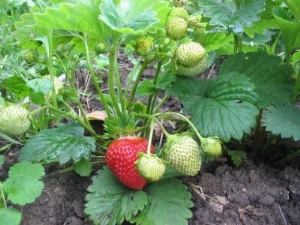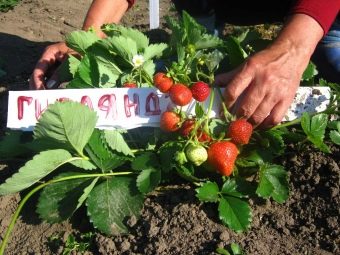Why do not strawberries give a mustache and what to do?

The juicy and sweet taste of strawberries makes it a “welcome guest” both in the country garden plots and in the fields of farms.However, obtaining a good harvest of this berry is impossible without taking into account the many nuances of agricultural technology, including the correct reproduction of plants. Often, new bushes are obtained with the help of the so-called mustache - long and thin leafless shoots, which let growing strawberry bushes. Therefore it is necessary to figure out in which cases the strawberry may not give a mustache, as well as understand what to do in such situations.
Reasons for the disappearance of the whiskers
There are several possible reasons due to which mustaches do not grow on the bushes of garden strawberries. The most common are:
- variety does not give a mustache in principle;
- plant lacks nutrients.
In turn, the lack of strength in the strawberry bush can be caused by the following reasons:
- abundant flowering and fruiting;
- disease;
- pest invasion;
- soil depletion;
- old age bush.
Thus, it is necessary to separate the cases when the strawberry does not allow the whiskers, in principle, due to the nature of the variety, and the situation when the same variety produced many whiskers last season, and the vegetative shoots do not grow this year.
In the first case, no special actions need to be taken, while in the second case, the disappearance of the whiskers may be an indication of serious problems that need to be urgently addressed in order not to lose the harvest.
Breeding with a mustache
Consider the peculiarities of agrotechnics during the breeding of strawberries with a mustache. The most important rule to remember is that for each individual bush you will have to choose whether this season it will be used for breeding or for harvesting. Even the healthiest bush of strawberries does not have enough strength to fully form both mustache and fruit. At best, small and not very juicy berries will grow on it.
therefore for breeding you need to choose the strongest bushes. In this case, in the first year of plant life, the mustache must be cut off from all growing bushes. First, biennial and three-year plants are much more “fruitful” in terms of mustache growth than annual ones. Secondly, in the first season it is necessary to allow all the bushes to bear fruit in order to choose the most suitable ones for subsequent reproduction. At the end of the season, those bushes that gave the largest berries, are deposited on a separate site, which is called the mother liquor.
The following year, in the mother liquor, it is important to closely monitor the condition of the bushes. First of all, you need to cut the flowers immediately after they appear. Only strawberries, not wasting power on flowering, provide a sufficient number of strong shoots. The mustache itself also needs to be subjected to selection - each let-out mustache takes a lot of strength from the plant. Therefore, all weak or damaged mustache should be immediately removed (cutting off or cutting off), leaving only the most promising.
When the mustache takes root and gives a "socket", it is not necessary to cut it off. It is better to just slightly deepen the roots of the formed bush. In the future, care of the outlet is carried out in the same way as for ordinary seedlings. There is another method of breeding with a mustache, when fresh sockets are immediately separated from the mother plant and transplanted into separate pots (or peat cups) for seedlings.
If the disappearance of the whiskers is caused by a disease or the presence of pests, sooner or later more specific symptoms will appear. As soon as the "diagnosis" can be made, it will be necessary to immediately begin treating the injured hives. If the disappearance of the shoots is accompanied only by the general lethargy of the plant, it means that the strawberries lack nutrients. In this case, you need to carry out fertilizing complex fertilizers, ash or manure.
If the mustache stopped growing due to old age (for most varieties this moment comes after eight years of life), then their growth will not be able to recover.
Varieties without a mustache
Many varieties of remontant strawberries (the so-called breeds that produce more than 1 time per season) basically do not form a mustache. The most famous varieties of strawberries, not giving a mustache:
- Ada;
- Ali Baba;
- "Albion";
- "Baron Solemacher";
- Brighton;
- "Bolero";
- Wim Rin;
- "Mount Everest";
- "Yellow Miracle";
- "Geneva";
- "Kent";
- "Yoke";
- “Royal Visit”;
- Crimean Remontant;
- Mara de Bois;
- Ruyana;
- "Rugen";
- "Autumn fun";
- Sakhalin Remontant.
Some varieties of remontant garden strawberries, although they give a mustache, but in a small amount, therefore, it is preferable to propagate them in the same way as beardless breeds. These varieties include:
- "Garland";
- "Elizabeth the Second";
- "Inexhaustible";
- "Selva";
- "Tristar".
Breeding without a mustache
If the strawberry you have chosen to grow does not provide enough whiskers or does not give them at all, then it can be propagated either with the help of seeds or by separating adult bushes. The rules for planting separated bushes coincide with the basics of agrotechnology when planting new strawberry bushes. The main thing is to prepare the site in advance, clean it of weeds and mulch the soil a week before the planned planting of the crop. A month later, you need to check how well planted bushes have taken root. If the plant looks noticeably weaker than the neighbors in the garden, it is better to remove it and plant a new bush on this place.
The easiest way to plant remontant varieties with seeds is to take a ripe berry, spread it on the ground and cover with sawdust. Having waited for shoots, it is necessary to determine the strongest bushes and transplant them to seedlings.
A more complicated and reliable way is to use seeds purchased or separated from the fruit. They need to be mixed with sand and evenly scattered on the surface of the planned beds. After that, the area is covered with agrofilm. The best time to plant a strawberry seed is the end of March or the beginning of April.
It is worth noting that, although stubble-free varieties are theoretically theoretically able to grow in one place for several seasons, in practice, in a few years the bushes become too thick, which reduces their productivity. therefore to maintain the ability of plants to bear fruit, it is necessary every four years to divide the bushes with a transfer of the separated part to a new bed.
About why strawberries do not give a mustache and what to do, see the next video.






























